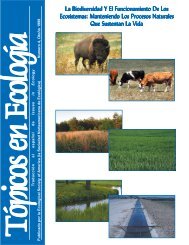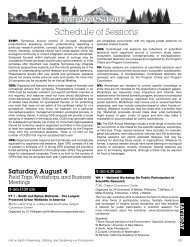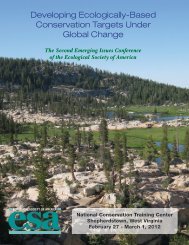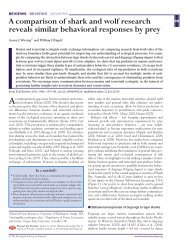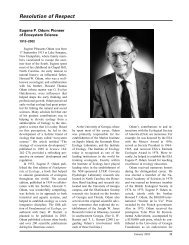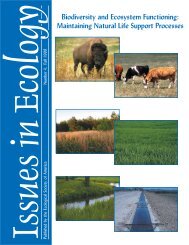Printed Program (PDF) - Ecological Society of America
Printed Program (PDF) - Ecological Society of America
Printed Program (PDF) - Ecological Society of America
You also want an ePaper? Increase the reach of your titles
YUMPU automatically turns print PDFs into web optimized ePapers that Google loves.
PS 30-132 Evans, B and V Borowicz, Illinois State University. Tolerance <strong>of</strong><br />
host plants to holoparasites depends on drought conditions.<br />
PS 31 - Plant-Insect Interactions<br />
Exhibit Hall DE, Oregon Convention Center<br />
PS 31-133 Korpita, T1, S Gomez2 and CM Orians1, (1)Tufts University,<br />
(2)University <strong>of</strong> Rhode Island. Effects <strong>of</strong> a mutualist and an<br />
antagonist on tomato’s primary metabolism.<br />
PS 31-134 Gonda-King, L, L Radville and EL Preisser, University <strong>of</strong><br />
Rhode Island. False ring formation in response to hemlock<br />
woolly adelgid feeding in eastern hemlocks.<br />
PS 31-135 Kjeldgaard, M, K Loewy and SM Murphy, University <strong>of</strong><br />
Denver. Local variation in host plant quality affects spatial<br />
distribution <strong>of</strong> fall webworms (Hyphantria cunea).<br />
PS 31-136 Flansburg, A, KJ Loewy and SM Murphy, University <strong>of</strong><br />
Denver. Effects <strong>of</strong> mid-development host switching on fall<br />
webworm (Hyphantria cunea) larval performance: evidence<br />
for compensatory growth.<br />
PS 31-137 Rios-Casanova, L, G Martinez and H Godinez-Alvarez,<br />
Universidad Nacional Autonoma de Mexico. Seed removal<br />
in transformed habitats: Pogonomyrmex barbatus and five<br />
cactus species in a semiarid zone <strong>of</strong> central Mexico.<br />
PS 31-138 Steets, JA, B Luttbeg and EJ Rebek, Oklahoma State<br />
University. The role <strong>of</strong> multitrophic interactions for mating<br />
system expression in Ruellia humilis.<br />
PS 31-139 Pante, E1, D Johnson2 and KJ Haynes3, (1)Université<br />
de La Rochelle, (2)Virginia Commonwealth University, (3)<br />
University <strong>of</strong> Virginia. Geographic variation in the effect <strong>of</strong><br />
drought on southern pine beetle outbreaks.<br />
PS 31-140 LeCroy, KA, PA Van Zandt and W Shew, Birmingham-<br />
Southern College. An analysis <strong>of</strong> nocturnal moth visitation<br />
to the flora <strong>of</strong> the Ketona dolomite glades <strong>of</strong> Bibb County,<br />
Alabama, USA.<br />
PS 31-141 Piper, FI1 and A Fajardo2, (1)Centro de Investigación<br />
en Ecosistemas de la Patagonia (CIEP), (2)Centro de<br />
Investigacioxn en Ecosistemas de la Patagonia. Leaf habit<br />
relates to herbivory tolerance in two Chilean Noth<strong>of</strong>agus<br />
species.<br />
PS 32 - Pollination<br />
Exhibit Hall DE, Oregon Convention Center<br />
PS 32-142 Paine, KC1 and TH Roulston2, (1)Blandy Experimental Farm,<br />
(2)University <strong>of</strong> Virginia. Thieves or friends: Are specialist<br />
bees more efficient at removing pollen than generalists?.<br />
PS 32-143 Gaines, HR and C Gratton, University <strong>of</strong> Wisconsin -<br />
Madison. Response <strong>of</strong> native bees to local farm management<br />
and landscape features in a perennial agroecosystem.<br />
PS 32-144 Phifer, C1, E Stacy2, J Price2 and C Giardina3, (1)University<br />
<strong>of</strong> Hawai‘i at Hilo, (2)University <strong>of</strong> Hawai’i at Hilo, (3)USDA<br />
Forest Service. Pollination ecology <strong>of</strong> Broussaisia arguta<br />
(Hydrangeaceae) in a fragmented forest on the Island <strong>of</strong><br />
Hawai‘i.<br />
PS 32-145 Faivre, AE1 and CW Weekley2, (1)Cedar Crest College,<br />
(2)Archbold Biological Station. Assessing pollen viability<br />
among genotypes <strong>of</strong> the federally endangered Florida<br />
ziziphus (Ziziphus celata) Rhamnaceae.<br />
PS 32-146 Alarcón, R, California State University Channel Islands. Are<br />
“generalists” poor quality pollinators?.<br />
PS 32-147 Domic, AI and G Camilo, Saint Louis University. Pollination<br />
biology <strong>of</strong> a high-altitude wind-pollinated tree species.<br />
PS 32-148 Schroeder, PC1, CS Ferguson1, KR Donham1 and ML<br />
Wineteer2, (1)Southern Oregon University, (2)Bureau<br />
<strong>of</strong> Land Management. Reproductive strategy <strong>of</strong> a rare<br />
gynodioecious shrub, Sidalcea hickmannii ssp. novum<br />
(Malvaceae), in southwestern Oregon.<br />
PS 32-149 Straka, JR and BM Starzomski, University <strong>of</strong> Victoria. On<br />
which mark do they get set? Seed set <strong>of</strong> alpine plants is<br />
limited by a combination <strong>of</strong> temperature, seed-predation,<br />
and pollination.<br />
PS 33 - Population Dynamics And Regulation<br />
Exhibit Hall DE, Oregon Convention Center<br />
PS 33-150 Cunnings, AM, University <strong>of</strong> Calgary. Modelling transport<br />
Life on Earth: Preserving, Utilizing, and Sustaining our Ecosystems<br />
4:30 pm-6:30 pm<br />
and deposition <strong>of</strong> fluvial dispersed seeds.<br />
PS 33-151 Ganzhorn, SM1, J Lewis1, WW Thomas2 and FA Gaiotto3,<br />
(1)Fordham University, (2)The New York Botanical Garden,<br />
(3)Universidade Estadual de Santa Cruz. Genetic diversity<br />
<strong>of</strong> Manilkara maxima: An ecologically and economically<br />
important tree species from a biodiversity hotspot.<br />
PS 33-152 Wall, WA1, WA H<strong>of</strong>fmann2, TR Wentworth2, JB Gray3<br />
and MG Hohmann1, (1)US Army Corps <strong>of</strong> Engineers<br />
ERDC - CERL, (2)North Carolina State University, (3)<br />
Fort Bragg. Short-term demographic effects <strong>of</strong> fire on<br />
two endemic plant species <strong>of</strong> the longleaf pine ecosystem.<br />
PS 33-153 Chu, C1, KM Havstad2, D Peters2 and PB Adler1, (1)Utah<br />
State University, (2)USDA Agricultural Research Service.<br />
Comparison <strong>of</strong> lifespan and survival for 114 herbaceous<br />
perennials across five ecosystems in the western US.<br />
PS 33-154 Ferguson, JM and JM Ponciano, University <strong>of</strong> Florida.<br />
Modeling extinction in experimental populations <strong>of</strong> Daphnia.<br />
PS 33-155 Menges, ES, SA Smith and SM McAllister, Archbold<br />
Biological Station. Post-fire cohort demography <strong>of</strong> Florida<br />
rosemary, a foundation shrub in Florida scrub.<br />
PS 33-156 Feldman, TS, The University <strong>of</strong> Wisconsin - Stevens Point.<br />
Demography and population viability <strong>of</strong> Fassett’s locoweed<br />
(Oxytropis campestris var. chartacea), a rare endemic plant<br />
growing on lake shores in Wisconsin.<br />
PS 33-157 Conway, AL, JP Carroll and SM Hernandez, University <strong>of</strong><br />
Georgia. The use <strong>of</strong> camera traps to estimate occupancy<br />
and describe activity patterns for the pygmy hippopotamus<br />
(Choeropsis liberiensis) on and around Tiwai Island, Sierra<br />
Leone.<br />
PS 33-158 Kellett, KM1 and RP Shefferson2, (1)Odum School <strong>of</strong><br />
Ecology, The University <strong>of</strong> Georgia, (2)University <strong>of</strong> Georgia.<br />
Well-seasoned demography: The importance <strong>of</strong> intraannual<br />
variation in populations <strong>of</strong> a Neotropical milkweed.<br />
PS 33-159 Hinkey, TK, SM Eppley and TN Rosenstiel, Portland State<br />
University. Temperature stress and the sex bias: The<br />
influence <strong>of</strong> heat-shock events on bryophyte population<br />
dynamics.<br />
PS 34 - Predation And Predator-Prey Interactions<br />
Exhibit Hall DE, Oregon Convention Center<br />
PS 34-160 Wacht Katz, M1, Z Abramsky1, BP Kotler2 and ML<br />
Rosenzweig3, (1)Ben-Gurion University, (2)The Jacob<br />
Blaustein Institutes for Desert Research, (3)University <strong>of</strong><br />
Arizona. Behavioral games between predators and prey:<br />
Little Egrets and Gold Fish in test environment.<br />
PS 34-161 Sendoya, SF, AVL Freitas and PS Oliveira, State University<br />
<strong>of</strong> Campinas - Unicamp. Ant-caterpillar interactions in<br />
a neotropical savanna: Defensive strategies against ant<br />
predation in an ant-rich environment.<br />
PS 34-162 Barry, MJ and S Syal, Sultan Qaboos University. Metabolic<br />
responses <strong>of</strong> tadpoles to diffusible predation cues.<br />
PS 34-163 Rafter, JL and EL Preisser, University <strong>of</strong> Rhode Island.<br />
Avoidance <strong>of</strong> prey toxicity by Chinese mantid, Tenodera<br />
sinensis.<br />
PS 34-164 Woltz, JM and DA Landis, Michigan State University. Effect<br />
<strong>of</strong> transient coccinellid immigration on aphid suppression.<br />
PS 34-165 Whitney, TD and JD Harwood, University <strong>of</strong> Kentucky.<br />
Tracking predation shifts in forest spiders over the cold<br />
season.<br />
PS 34-166 Crumrine, PW1, S Kawecki2 and L Oquendo Diaz3, (1)<br />
Rowan University, (2)Loyola Marymount University, (3)<br />
University <strong>of</strong> Puerto Rico Bayamon. Differences in prey<br />
preference among top predators affects the size structure<br />
<strong>of</strong> prey communities.<br />
PS 34-167 Hembre, LK, T Olson and D Carlson, Hamline University.<br />
Effects <strong>of</strong> fisheries management and the timing <strong>of</strong><br />
stratification on the eutrophication <strong>of</strong> a Minnesota Lake.<br />
PS 35 - Distributions And Range Limits<br />
Exhibit Hall DE, Oregon Convention Center<br />
PS 35-168 Chick, LD, KL Stuble, DA Fowler and NJ Sanders,<br />
University <strong>of</strong> Tennessee. The relationship between inter-<br />
and intraspecific variation in critical thermal limits and the<br />
distribution <strong>of</strong> ant biodiversity, now and (maybe) in the<br />
TUESDAY<br />
95



